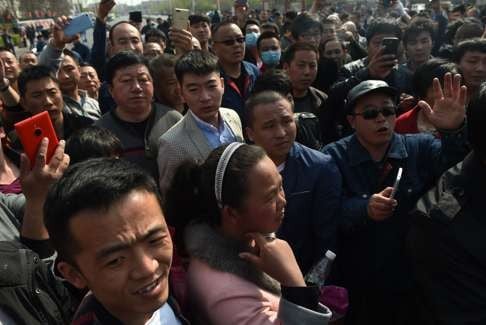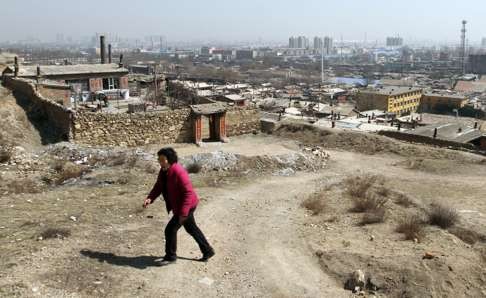
The big workaround: how China is trying to avoid job cuts while shutting down bloated industry
In the second of a two-part series, we look at how the mainland is trying to cut industrial capacity without the pain of mass lay-offs
Li Guixian spends much of her time either watching television or, when the weather is warm, dancing outdoors with her friends.
The former equipment manager in the coal-mining city of Datong is just 49 years old but she is already four years into “internal retirement”, surviving on a monthly stipend from her former employer Datong Coal Mining Group.
She stopped working in 2012 when she was put on indefinite furlough, albeit with regular payments and benefits. “It’s retirement, although the monthly income is less than that for older retirees,” she said.
When Li turns 50, her pension will be paid by the state, instead of her state employer, and she will officially retire. At no point will she officially join the ranks of the country’s unemployed.
The redesignation of staff to this twilight zone of “internal retirement” is one of the various ways Beijing hopes to achieve a delicate balancing act: shutting down excess industrial capacity on one hand and avoiding massive unemployment on the other.
Rise of China’s internet and service sectors offer hope for new graduate jobseekers
And, despite headline-grabbing reports of worker unrest in the country’s rust-belt regions, there are signs that Beijing just might do it. The central government has set up a special 100 billion yuan (HK$120 billion) fund to promote such lay-offs and rearrangements. Even without additional fiscal input from local governments and state employers, the fund can pay more than 50,000 yuan each to 1.8 million workers expected to be retrenched in the coal and steel industries.
It’s a good arrangement for state company employees. Instead of being sacked, they can still receive allowances and corporate welfare contributions, without actually working
“Internal retirement” is undergoing a revival in heavy industry after first becoming popular in the 1990s as a way for state firms to cut costs. In general, an employee can apply to quit working if he or she has only five years to go until official retirement. But instead of being “unemployed”, workers continue to be tied to the state employer and receive allowances and social welfare contributions from the company. The payments are often a fraction of the regular salary.
“It’s a good arrangement for state company employees. Instead of being sacked, they can still receive allowances and corporate welfare contributions, without actually working,” said Su Hainan, vice-president of the China Association for Labour Studies. “But there’s no number available to gauge how many people are actually being covered in this programme.”

Communist Party cadres running state factories also resort to “job swaps” or “diversions” as a way to avoid the word “unemployment”. These schemes can involve redeploying workers to lower-level jobs or effectively putting them on part-time duties. The staff stay on the company’s books but are paid much less.
On recent example was last month when Shanxi Coal Elec tricity Group sought to reassure its employees that a “job transfer is not a lay-off, diversion is not being unemployed”.
The terms date back 30 years to when China began to unmake its centrally planned system by downsizing bloated state enterprises. Peking University economics professor Chen Yuyu said the arrangements came about to take into consideration China’s “own conditions and historical situation”. That historical situation included a combination of he very real threat of social unrest from unemployed workers and ideological constraints – making legions of state workers jobless runs counter to the party’s own definition as the vanguard of China’s working class.
“If a US worker is laid off, he can go to the labour market to look for a way to make a living, but if a Chinese worker is laid off, he can go protest in front of the local government building,” Chen said.
That hesitation over cutting staff continues to this day. When mainland media reported late last year that Wuhan Iron and Steel, one of the country’s biggest state-owned steel plants, was cutting jobs, the company immediately responded that it didn’t “cut jobs”. It just rolled out “internal retirement” and “temporary work suspensions” for thousands of workers, which “didn’t change employment relations”.
Decline and fall: the broken dreams of a Chinese coal-mining city struggling to address industrial overcapacity
One thing that has changed is the state-owned sector’s role in providing jobs. State-owned enterprises employed about 63.12 million people at the end of 2014, or about half the total from two decades earlier.
In the scheme of things, the number of job cuts China needs to make in the state sector is small given the growing undersupply of labour. The labour ministry estimated China would cut 1.8 million jobs in coal and steel, and many analysts said the actual size might be greater if other bloated sectors were included. But it’s still not a grave threat.
Compared to the late 1990s when then premier Zhu Rongji axed 30 million state jobs, China today has a much bigger economy and a better social security network to help absorb the shocks. “From a nationwide point of view, employment is actually not a big problem,” said Shen Jianguang, chief economist for Mizuho Securities Asia in Hong Kong. “Judged by the fact that wages are still rising, the overall job market is still short of supply.”

The service sector now accounts for the lion’s share of the economy and is soaking up the losses from bleeding industrial activity. On the supply side, the labour pool has started to shrink, easing the pressure to create low-end jobs.
“There are two interesting things in the global economy – China’s rapid slowdown is not translating into widespread unemployment while the US economic recovery is not leading to significant improvement in employment,” Chen said. “In China’s case, there are underlying shifts in economic structure and demographic picture.”
China’s rapid slowdown is not translating into widespread unemployment while the US economic recovery is not leading to significant improvement in employment
Labour skills were changing as well, he added. According to Chen, only 3 per cent of Chinese born in 1970 had access to a college education, with the rate rising to 10 per cent for those born in 1980 and 20 per cent for those born in 1990. The ratio will rise to 55 per cent for those born in 2000.
But while Beijing could relax about nationwide employment, it should be worried about “possibly severe” situations in specific places where a plant or a mine provided not only jobs but the community’s lifeline, Su said.
Standard Chartered chief China economist Ding Shuang agreed, saying China was better positioned economically and financially than two decades ago, but would face new challenges. “People are more aware of their rights, and they have a stronger understanding of protecting their own interests, and from this point of view … it’s more likely to lead to mass incidents than two decades ago” in laying off workers.
It can also spread to downstream businesses. Su Zhihua, a manager with a private firm that makes pipes for coal mining, said his company had cut more than half of its workforce in the last three years because it was getting hard to sell products and to receive payments.
“After Lunar New Year, about 30 workers were dismissed,” Su said.
“It’s just easier for private businesses to hire and fire workers.”

